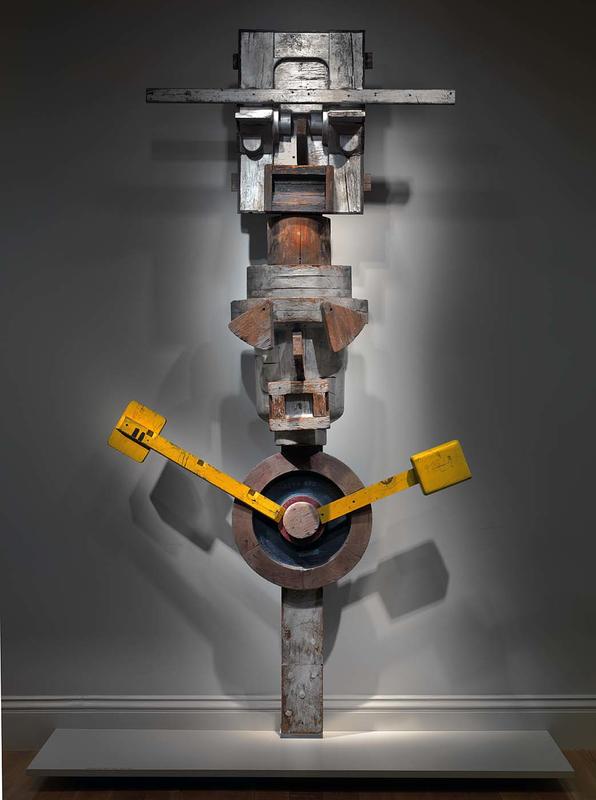More about Yielding to the Ancestors While Controlling the Hands of Time
- All
- Info
- Shop

Sr. Contributor
Lonnie Holley is one part Lee Bontecou, one part Robert Rauschenberg, and one part Toni Morrison.
Lee Bontecou because Holley uses discarded materials, particularly metal, in his works. Robert Rauschenberg because he assembles these found materials to make new, sculptural formations. In 2014, he solidified this artistic relationship by completing a month-long residency at the Robert Rauschenberg Foundation in New York. And Toni Morrison because his works communicate the deeply social and political ideologies concerning the African American experience. And by the way, Holley didn’t start making art until he was 29 years old. He was a bit of a late bloomer and is totally self-taught. Move over, Rousseau and Grandma Moses. We’ve got a new self-taught artist in town.
Holley’s sculptures have a public function that reflect the narrative history of African Americans in the Southern United States, and his material of choice, found scrap metal, helps to tell this story. After the Southern agrarian economy collapsed in the late 1800s, former sharecroppers and tenant farmers were hardpressed for work. Many searched for jobs in the growing iron and steel industries and traveled to urban centers throughout the South, like Birmingham, Alabama, where Holley now lives and works. His sculptures appeal to both the complicated past and possible future of this legacy.
Unlike the funny public sculptures of Claes Oldenburg, Holley’s works are inspired by a more serious social and political message. Think Kara Walker-esque concepts, but in found-metal sculptures. Yielding to the Ancestors While Controlling the Hands of Time has two heads – talk about having a split personality. One head is earthly, and the other is spiritual, and Holley explains that this refers to the two realities that everyone experiences: the one that you make for yourself, and the one that is influenced by your ancestors. Although Holley might have been content to make sculptures to turn his own yard into an artistic environment, Bill Arnett, a collector and supporter of self-taught Southern African American artists like Holley and Thornton Dial, began collecting Holley’s work in the 1980s. This work is a gift of Arnett’s to the Smithsonian.
But Holley doesn’t let this growing awareness of his talents go to his head. In addition to becoming a more well-known artist, he’s also a musician who improvises everything, both music and lyrics, each time he performs and has shared the stage with Animal Collective and Dirty Projectors. His art reminds us that, to build a better future, we must acknowledge our past and those who have come before us. And as Lonnie so eloquently puts it himself, “Thumbs up for Mother Universe.”
Sources
- Souls Grown Deep Foundation. “About Souls Grown Deep Foundation.” http://www.soulsgrowndeep.org/foundation. Accessed May 28, 2017.
- Smithsonian American Art Museum. “Folk and Self-Taught Art Galleries, Smithsonian American Art Museum, Wall Label Text.” https://americanart.si.edu/pr/library/2016/folk%20art/folk_art_2016_wal…. Accessed May 28, 2017.
- Robert Rauschenberg Foundation. “Past Residents.” http://www.rauschenbergfoundation.org/residency/past-residents. Accessed May 29, 2017.
- Ringle, Hallie. “Living History: Narratives of the South.” Studio: The Studio Museum in Harlem Magazine (Winter/Spring 2014). https://www.studiomuseum.org/sites/default/files/winter_spring_2014_stu…. Accessed May 28, 2017.
- Reynolds, John and Lee Donaldson. Something to Take My Place: The Art of Lonnie Holley. August 13, 2015, https://vimeo.com/136211585?ref=em-share. Accessed May 28, 2017.
- Binelli, Mark. “Lonnie Holley, the Insider’s Outsider.” New York Times. January 23, 2014. https://www.nytimes.com/2014/01/26/magazine/lonnie-holley-the-insiders-…. Accessed May 28, 2017.












